
Generally, beef herd pregnancy rates after a 60–120-day breeding season tend to range from 80 to 94 percent. Pregnancy diagnosis identifies the 6–20 percent of open cows in the herd so they can be culled after their calves at side are weaned, instead of waiting to the end of the subsequent calving season. Considering that the annual feed/forage costs associated with maintaining a mature cow can be as high as $400 to $600 per year, culling open cows can save as much as $250 per head that can be diverted to the purchase or development of replacement females, sire selection, increased nutritional management, and other management-related costs. Pregnancy diagnosis can be performed simply at the time that producers work their cattle during their vaccination schedule or even at the time of weaning. There are three practical methods that can be utilized for pregnancy diagnosis in beef herds: 1) rectal palpation, 2) transrectal ultrasonography, or 3) use of a blood sample that is submitted to a laboratory for analysis and results returned to the producer within a few days.
Rectal palpation is an accurate form of pregnancy diagnosis that can be performed by a skilled technician after day 35 of pregnancy throughout gestation until birth. Most veterinarians are proficient at pregnancy diagnosis in the form of rectal palpation and it is a simple procedure that requires little time in the cattle-handling facility. However, rectal palpation does not provide any information about the viability of the embryo/fetus. Therefore, some animals with a nonviable embryo/fetus or an embryo/fetus in the process of degenerating might be diagnosed as pregnant. Costs of rectal palpation vary widely based on the number of females to be handled, the distance that a veterinarian must travel, or the time and facilities used. Generally, rectal palpation costs will range from $2.50 to $15.00 per female. A primary advantage of rectal palpation is that the result is chute-side, with an immediate diagnosis that allows a producer to make a decision while the cow is in the chute.
Transrectal ultrasonography, more commonly called ultrasound, can be used to detect pregnancy as early as 26 days of gestation for heifers and 28 days of gestation for cows, with a high degree of accuracy. For a skilled technician, the procedure is as fast as rectal palpation and may provide additional information in terms of embryo/fetus viability, incidence of twins, and potentially the sex of the fetus (usually performed around day 55 of gestation). Prior to the development of ultrasound for pregnancy diagnosis in cattle, technicians were unable to accurately determine the viability or number of embryos or fetuses. Because the heartbeat of a fetus can be detected at approximately 22 days of age, one can accurately assess whether or not the pregnancy is viable. Producers also should be aware that early embryonic loss is a natural occurrence in cattle and may be evident between the time of pregnancy diagnosis and calving, and that this is not the result of the actual pregnancy diagnosis procedure. For example, we have observed about a 4.2 percent incidence of embryonic loss in beef heifers initially ultrasounded at day 30 of gestation and subsequently palpated rectally between day 60 and day 90 after insemination. In beef cows embryonic loss ranges from 3 to 8 percent from 30 to 75 days of gestation, whereas in dairy cattle, pregnancy loss from 28 to 56 days after artificial insemination was 13.5 percent. Therefore, ultrasonography provides a tool to accurately differentiate between the failure of a female to conceive and the incidence of embryonic mortality, because a heartbeat is detectable at 22 days of gestation.
Blood samples are now a suitable alternative for determination of pregnancy. There are at least two primary blood sample pregnancy test kits (BioPRYN and PG29). Blood samples are taken to evaluate for pregnancy-associated glycoproteins (PAG). Heifers and lactating cows can be tested 30 days or later after breeding. Lactating cows carry residual PAG from the previous pregnancy until 90 days after calving. To prevent receiving a false-positive test result, producers should sample blood 30 days or more after the conclusion of the breeding season, and 90 days or more after calving. Thus if a cow is bred 60 days after calving, it is appropriate to take the sample 30 days post-breeding, which is 90 days after calving. If she is bred 55 days after calving, then the post-breeding sample should be taken at 35 days so that the cow is 90 days post-calving.
The blood tests are greater than 99 percent accurate if the result is negative or not pregnant, with less than 1 percent showing false-open (false-negative). The false-pregnant (false-positive) rate for the test is approximately 5 percent. In practice, high-producing dairy cows tend to show slightly higher false-positive rates of 7 to 8 percent, especially during periods of extremely hot weather. It is presumed that a portion of this variance is due to greater early embryonic death and not to the inaccuracy of the blood test. The tests cost between $2.40 to $4.00 per cow from the laboratory that processes and conducts the test, plus the cost of a sample tube and needle. Shipping expenses also must be added if the tests are not processed locally. A primary drawback of this method of pregnancy diagnosis is that results are not immediate. A producer must wait for the results to be sent from a laboratory before a diagnosis is confirmed. This period varies between 2 and 5 days depending on when the laboratory receives the samples.
Producers interested in using a blood test can find additional information on the following websites:
BioPRYN Blood Pregnancy Test
DG29™ Blood Pregnancy Test
 0
0
